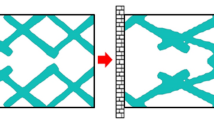Abstract
The deployment of a solar array is simulated three-dimensionally using the multibody program SIMPACK. The analyses are performed for 500 real-time seconds, which contain the three deployment phases, (I) jump-out, (II) steering phase and (III) deployed phase. The goal of the simulations is to check the influence of the flexibility of the solar array on the solar generator motions during these three phases against results obtained by a rigid body model simulation.
The modelling of flexible bodies is based on the widely used method of floating frame of reference formulation applying global shape functions (Ritz method). The preparation of a proper set of shape functions to represent the flexibility of the yoke and the six solar panels is one of the main objectives of thispaper. For each of the components, eigenmodes and static modes forvarious boundary conditions are computed using the finite elementprogram NASTRAN.
For a good convergence of the Ritz approximation with a smallnumber of shape functions, the shape functions are selected usingmodal participation factors, that are computed for various load casesprior to the time simulations. The load cases are obtained, for example,by a rigid body simulation of the deployment phases. The proposed methodof shape function selection using modal participation factors isdemonstrated by examples.
Similar content being viewed by others
References
Bremer, H. and Pfeiffer, F., Elastische Mehrkörpersysteme, Teubner Studienbücher, Mechanik, Teubner, B.G., Stuttgart, 1992.
Dietz, S., Vibration and Fatigue Analysis of Vehicle Systems Using Component Modes, Fortschr. Berichte VDI, Reihe 12, Nr. 401, VDI-Verlag, Düsseldorf, 1999.
Eich-Soellner, E. and Führer, C., Numerical Methods in Multibody Dynamics, Teubner-Verlag, Stuttgart, 1998.
Hagedorn, P., ‘The Rayleigh-Ritz method with quasi-comparison functions in nonself-adjoint problems’, Journal of Vibration and Acoustics 115, 1993, 280-284.
Meirovitch, L. and Hagedorn, P., ‘A new approach to the modelling of distributed non-selfadjoined systems’, Journal of Sound and Vibration 178(2), 1994, 227-241.
Meirovitch, L. and Kwak, M.K., ‘Convergence of the classical Rayleigh-Ritz method and the finite element method’, AIAA Journal 28(8), 1990, 1509-1516.
Otter, M., Hocke, M., Daberkow, A. and Leister, G., ‘An object oriented data model for multibody systems’ in Proceedings of the International Symposium on Advanced Multibody System Dynamics, W. Schiehlen (ed.), Kluwer Academic Publishers, Dordrecht, 1993, 19-48.
Roberson, R.E. and Schwertassek, R., Dynamics ofMultibody Systems, Springer-Verlag, Berlin, 1988.
Rulka, W., ‘SIMPACK, A computer program for simulations of large-motion multibody systems’ in Multibody System Handbook, W. Schiehlen (ed.), Springer-Verlag, Berlin, 1990, 265-284.
Schwertassek, R., ‘Flexible bodies in multibody systems’ in Computational Methods in Mechanical Systems, J. Angeles and E. Zakhariev (eds), Springer-Verlag, Berlin, 1997, 329-363.
Schwertassek, R. and Wallrapp, O., Dynamik flexibler Mehrkörpersysteme, Vieweg Verlag, Braunschweig, 1999.
Shabana, A.A., ‘Resonance conditions and deformable body coordinate systems’, Journal of Sound and Vibration 192(1), 1996, 389-398.
Shabana, A.A., ‘Flexible multibody dynamics: Review of past and recent developments’, Multibody System Dynamics 1, 1997, 189-222.
Spanos, J.T. and Tsuha, W.S., ‘Selection of component modes for flexible multibody simulation’, Journal of Guidance 14(2), 1991, 278-286.
Verlinden, O., 'simulation du comportement dynamique de systemes multicorps flexibles comportant des membrures de forme complexe’ Ph.D. Thesis, Faculté Polytechnique de Mons, 1994.
Wallrapp, O., ‘Standard input data of flexible members for multibody system codes’ in Advanced Multibody System Dynamics-Simulation and Software Tools, W. Schiehlen (ed.), Kluwer Academic Publishers, Dordrecht, 1993, 445-450.
Wallrapp, O., Beam-A Pre-Processor for Mode Shape Analysis of Straight Beam Structures and Generation of the SID File for MBS Codes, User' Manual, Deutsche Forschungsanstalt für Luft-und Raumfahrt (DLR), Inst. Robotik und Systemdynamik, Oberpfaffenhofen, Report Version 3.0, 1994.
Wallrapp, O., ‘Standardization of flexible body modeling in multibody system codes, Part I: Definition of standard input data’, Mechanics of Structures and Machines 22(3), 1994, 283-304.
Wallrapp, O., Eichberger, A. and Gerl, J., FEMBS-An Interface between FEMCodes and MBS Codes, User Manual for ANSYS, NASTRAN, and ABAQUS, INTEC GmbH, Wessling, Report Version 3.0, 1997.
Wiedemann, S., ‘Entfaltanalyse Solargenerator unter Berücksichtigung von Elastizitäten mit SIMPACK’, Diplomarbeit, Fachhochschule München-Munich University of Applied Sciences, 1999.
Author information
Authors and Affiliations
Rights and permissions
About this article
Cite this article
Wallrapp, O., Wiedemann, S. Simulation of Deployment of a Flexible Solar Array. Multibody System Dynamics 7, 101–125 (2002). https://doi.org/10.1023/A:1015295720991
Issue Date:
DOI: https://doi.org/10.1023/A:1015295720991




